
It's been quite sometime since I've been able to put up a real update. Currently, my students are engaged in developing their skills in the realm of 3D software (SketchUp and Rhino). They have been given small assignments that relate back to their first assignment, the documentation of the mechanical object. In these exercises they were tasked with using the computer to figure out connections and abstracting geometries from objects in photographs. I've instructed them that they need to be part detective in order to figure these things out.
Which brings us to our second major assignment. Using the compositions they've developed by hand, they are now tasked to document the motion of their mechanical objects. Turning, twisting, folding, spreading, rolling, are adjectives that they need to translate into visual cues. From there, the students will abstract these motions into what will appear to be, at first glance, a "random" shape.
These shapes will then be refined in Rhino and made into a design for a seat (think chair, bench, couch, etc..), which will then be assembled from our CNC machine. Below are some images of their process pinup. Stay tuned for more. We hope to have mockups by next week

Chiou, originally a horticulturist and landscape designer, equates his object (the umbrella) to the blooming of a flower/plant in his studies.

Anthony creates the following studies based off his quick grip clamp.
Carlos does some quick movement analysis of his wine opener.

Liu presents her motion diagrams based off the speed and revolutions given by a standard caster.
This blog gives a sneak peak into the architecture world at the University of Miami. What began as an experiment following one group of incoming graduate students through their first semester of design, has morphed into a window of the school of architecture through this professor's eyes. I will try to post as often as possible.
No Comments
Block this user
Are you sure you want to block this user and hide all related comments throughout the site?
Archinect
This is your first comment on Archinect. Your comment will be visible once approved.